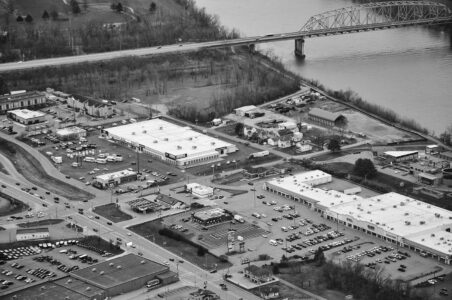Powering the USA, keeping our lights on
This week, we have an Israeli delegation visiting West Virginia. They are looking for a site for their U.S. HQ & Research Center.
Ido, one of the delegates, asked if there was a place he could buy a fishing rod for his son. I took them to Cabela’s. Ido was overwhelmed as soon as he saw several aisles of fishing rods: “I’m going to need some help.”
He bought two collapsible rods, one for his son and one for himself, along with tackle. They loved the stuffed game animals and large fish tank.
Another delegate was amazed at the variety of firearms. He commented, “You can buy these?”
The size of the store and large variety of merchandise amazed them. “We don’t have anything like this.”
Sometimes we don’t realize how blessed we are, not just to have Cabela’s, but to the have all the places to hunt and fish in the region. It is easy to take our many forests, streams, clean air, clean water, abundant wildlife and fish for granted. Foreign visitors typically comment, “How green it is here.”
When we moved to West Virginia over 40 years ago, we rarely saw a deer. Now two deer herds roam the neighborhood. In addition to racoons and possums, we have red foxes. On our last trip to Morgantown, we saw a black bear walking along I-79. The air and water are the cleanest of my life, and we are surrounded by fracked gas wells. My neighbor found a snapping turtle in his pool last summer. That was a surprise. They relocated it.
We can provide dependable energy to the nation and have a clean environment. That’s a good thing, because the USA and the world need energy.
This week, we were at the West Virginia Energy Summit in Charleston. Gov. Patrick Morrisey opened the summit by announcing five energy projects with an investment of $4.2 billion creating over 4,000 jobs. This included two natural gas power plants producing almost 2 GW of important baseload power.
The governor’s goal is for West Virginia to produce 50 GW of power by 2050. After this announcement, West Virginia only needs 33 additional gigawatts or 11 more power plants equal to the 3 GW John Amos power plant, the largest in the state.
The governor’s plan includes all energy sources. He made it clear continued coal power and natural gas will provide most of the baseload power increases in the near term. Nuclear power will eventually contribute, but not until sometime after 2030.
First Energy, AEP and Dominion attended and presented their demand estimates of 70 to 170 GW. This includes AI-increased demand. They are trying to determine how much of this will actually happen and how much is duplicative.
Data centers will require large amounts of power. Some will have their own power plants behind the meter. Others will require power from our regional power grid, PJM. New manufacturing projects will also increase demand for electricity. Ohio started seeing this in 2021 ahead of any data center demand.
A PJM representative spoke and told us they take all watts from any power source. In the last five years, to support the previous administration’s decarbonization efforts, PJM had 200 GW of renewable power in queue. Few of the approved projects got built due to lack of funding or local permit difficulties. This would not have helped our need for baseload 24/7/365 power. This year,
63 GW of mostly natural gas power has been approved to meet current short-term power needs. These are shovel-ready projects that will be built.
PJM currently has 182,000 MW of total supply. Peak demand for 2025 is 162,000 MW. Peak demand in 2040 is expected to be 212,000 MW. The power grid always has to base its needs on peak demand, the maximum expected demand of air conditioning for extreme heat in summer or heat for extreme cold in winter. The PJM grid needs to send electricity to our homes even on extremely hot or cold nights when solar can’t contribute. This is why we need baseload power like natural gas, coal or nuclear. PJM expects to need another 50 GW to handle peak demand.
The PJM speaker explained something we rarely hear about, “capability of generator classes,” which means how much of rated capacity can be expected from a power source. For nuclear power it is 95%. Coal is 84%. Natural gas is 79%. Onshore wind is 35%. Solar is 9%. What this means is for a 100 MW solar project only 9 MW can be counted on for delivery. We learned West Virginia ranks 49th in the USA for the number of sunny hours
The good news is we have the fuel to meet this baseload demand from natural gas primarily, coal and eventually some nuclear. The challenge isn’t fuel; it is getting the natural gas to new power plants, requiring infrastructure like pipelines. There is also a shortage of gas turbines to be dealt with. Data centers are signing long term natural gas contracts to make sure they have gas for their data center projects.
What does this all mean? This is not about emotion or opinion. It is about basic engineering. Shutting down baseload coal and relying on renewables put us in a dangerous situation and almost created life-threatening blackouts. Our PJM grid will be able to keep the lights, heat and AC on for peak day currently. We will need to build more natural gas power plants and pipelines. That process needs to start now. Following basic engineering principles, we can have power and a clean environment.
Next week, Shale Crescent USA will be in Toronto for a U.S. Commercial Services Roadshow event. Companies from Canada are looking to move manufacturing to the USA where their customers are located. Currently we have eight manufacturing companies scheduled to meet with us. We have the power to attract manufacturing jobs for people in the region.
Greg Kozera, gkozera@shalecrescentusa.com, is the director of marketing for Shale Crescent USA. He is a professional engineer with a masters in environmental engineering and over 40 years of experience in the energy industry. Greg is a leadership expert, high school soccer coach, professional speaker, author of four books and many published articles.



